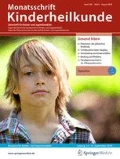Zusammenfassung
Gesundheitsriskantes Verhalten ist nach wie vor ein wichtiges Thema der Prävention und Gesundheitsförderung. Insbesondere soziale Variationen gesundheitsbezogenen Verhaltens geben Hinweise für die Gestaltung und Umsetzung von Interventionen. Die Ergebnisse der HBSC-Studie („health beaviour in school-aged children“; 2009/2010), in deren Rahmen 5005 Schüler/-innen allgemeinbildender Schulen aus allen Bundesländern (mit Ausnahme Baden-Württembergs) im Alter zwischen 11 und 15 Jahren mit Hilfe eines standardisierten Fragebogens befragt wurden, werden berichtet. Die Studie fokussierte auf gesundheitsrelevantes Verhalten, subjektive Gesundheit und soziale Determinanten. 6,4% der 11- bis 15-jährigen Mädchen und 5,9% der gleichaltrigen Jungen gaben an, mindestens 1-mal/Woche zu rauchen. Der Alkoholkonsum nahm mit dem Alter zu und war in wohlhabenden Familien häufiger: 15,3% der 15-jährigen Mädchen und 28,1% der gleichaltrigen Jungen gaben an, mindestens 1-mal/Woche Alkohol zu trinken. Jeder 10. Jugendliche hat Erfahrung mit Cannabis. Obwohl gesundheitsriskantes Verhalten insgesamt rückläufig ist, verdienen Alkohol, Tabak und illegale Drogen weiterhin Aufmerksamkeit, v. a. unter Berücksichtigung der sozialen Variationen.
Abstract
Health risk behaviour is an important issue for health promotion and prevention. Analyzing social determinants of health-related behaviour provides indications for the design and implementation of health promotion and prevention. The article reports the results of the German Health Behaviour in School-aged Children study (HBSC) 2009/2010. A total of 5,005 adolescents aged 11–15 years from secondary schools in all federal states except one (Baden-Württemberg) filled in a standardized questionnaire. The study focused on health-related behaviour as well as self-rated health and social determinants. 6.4% of 11 to 15-year-old girls and 5.9% of boys at the same age smoked at least once a week. Alcohol consumption increased with age showing that 15.3% of 15-year-old girls and 28.1% of boys at the same age drank alcohol at least once a week with adolescents from affluent families showing higher prevalence rates. Every tenth adolescent reported having tried cannabis. Although health risk behaviour is decreasing, alcohol, tobacco and illegal drugs still need attention for intervention, especially in terms of variations.




Literatur
BZgA – Bundeszentrale für gesundheitliche Aufklärung (2011) Der Alkoholkonsum Jugendlicher und junger Erwachsener in Deutschland 2010. BZgA, Köln
Currie C, Molcho M, Boyce W et al (2008) Researching health inequalities in adolescents: the development of the health behaviour in school-aged children (HBSC) family affluence scale. Soc Sci Med 66(6):1429–1436
DeWit DJ, Adlaf EM, Offord DR, Ogborne AC (2000) Age at first alcohol use: a risk factor for the development of alcohol disorders. Am J Psychiatry 157(5):745–750
Drogenbeauftragte der Bundesregierung, Bundesministerium für Gesundheit (2011) Drogen- und Suchtbericht 2011. Bundesministerium für Gesundheit, Berlin
Ghandour RM, Overpeck MD, Huang ZJ et al (2004) Headache, stomachache, backache, and morning fatigue among adolescent girls in the United States: associations with behavioral, sociodemographic, and environmental factors. Arch Pediatr Adolesc Med 158(8):797–803
Hall W, Degenhardt L (2009) Adverse health effects of non-medical cannabis use. Lancet 374(9698):1383–1391
HBSC-Team Deutschland (2011) Studie Health Behaviour in School-aged Children – Faktenblatt „Binge Drinking/Rauschtrinken bei Kindern und Jugendlichen“. WHO Collaborating Centre for Child and Adolescent Health Promotion, Bielefeld
HBSC-Team Deutschland (2012) Studie Health Behaviour in School-aged Children – Faktenblatt „Alkoholkonsum von Kindern und Jugendlichen“. WHO Collaborating Centre for Child and Adolescent Health Promotion, Bielefeld
Hibell B, Guttormsson U, Ahlström S et al (2009) The 2007 ESPAD report – substance use among students in 35 European countries. The Swedish Council for Information on Alcohol and Other Drugs (CAN), Stockholm
Hublet A, Schmid H, Clays E et al (2009) Association between tobacco control policies and smoking behaviour among adolescents in 29 European countries. Addiction 104:1918–1926
Jarvis MJ (2004) Why people smoke? BMJ 328:277–279
Kuntsche E, Simons-Morton B, Fotiou A et al (2009) Decrease in adolescent cannabis use from 2002 to 2006 and links to evenings out with friends in 31 European and North American countries and regions. Arch Pediatr Adolesc Med 163:119–125
Kuntsche E, Kuntsche S, Knibbe R et al (2011) Cultural and gender convergence in adolescent drunkenness: evidence from 23 European and North American countries. Arch Pediatr Adolesc Med 165:152–158
Nic Gabhainn S, Baban A, Boyce W, Godeau E (2009) How well protected are sexually active 15-year olds? Cross-national patterns in condom and contraceptive pill use 2002–2006. Int J Public Health [Suppl 2] 54:209–215
Petermann F, Helbig S (2008) Entwicklungsaufgabe „Substanzgebrauch“. Bewältigungskompetenzen und Ressourcenförderung bei Jugendlichen und jungen Erwachsenen. Sucht Aktuell 2:14–19
Rehm J, Room R, Monteiro MG (2004) Alcohol use. In: Ezzati M, Lopez AD, Rodgers A, Murray CJL (Hrsg) Comparative quantification of health risks: global and regional burden of disease attributable to selected major risk factors, Bd 1. World Health Organization, Genf, S 959–1108
Richter M, Leppin A, Nic Gabhainn S (2006) The relationship between parental socio-economic status and episodes of drunkenness among adolescents: findings from a cross-national survey. BMC Public Health 6:289
Schenk L, Ellert U, Neuhauser H (2007) Kinder und Jugendliche mit Migrationshintergrund in Deutschland. Methodische Aspekte im Kinder- und Jugendgesundheitssurvey (KiGGS). Bundesgesundheitsblatt Gesundheitsforschung Gesundheitsschutz 50(5, 6):590–599
Simons-Morton BG, Farhat T, ter Bogt TF et al (2009) Gender specific trends in alcohol use: cross-cultural comparisons from 1998 to 2006 in 24 countries and regions. Int J Public Health [Suppl 2] 54:199–208
WHO (2009) Global health risks: mortality and burden of disease attributable to selected major risks. World Health Organization, Genf
Interessenkonflikt
Die korrespondierende Autorin gibt für sich und Ihren Koautor an, dass kein Interessenkonflikt besteht
Author information
Authors and Affiliations
Consortia
Corresponding author
Additional information
Das HBSC-Team Deutschland setzt sich aktuell aus folgenden Standorten zusammen: Universität Bielefeld (Leitung: Prof. Dr. Petra Kolip); Technische Universität Dresden (Leitung: Prof. Dr. Wolfgang Melzer); Fachhochschule Frankfurt am Main (Leitung: Prof. Dr. Andreas Klocke); Universitätsklinikum Hamburg-Eppendorf (Leitung: Prof. Dr. Ulrike Ravens-Sieberer)
Rights and permissions
About this article
Cite this article
Kolip, P., Bucksch, J. & Deutsches HBSC-Team. Gesundheitsriskantes Verhalten im Jugendalter. Monatsschr Kinderheilkd 160, 657–661 (2012). https://doi.org/10.1007/s00112-011-2612-2
Published:
Issue Date:
DOI: https://doi.org/10.1007/s00112-011-2612-2

